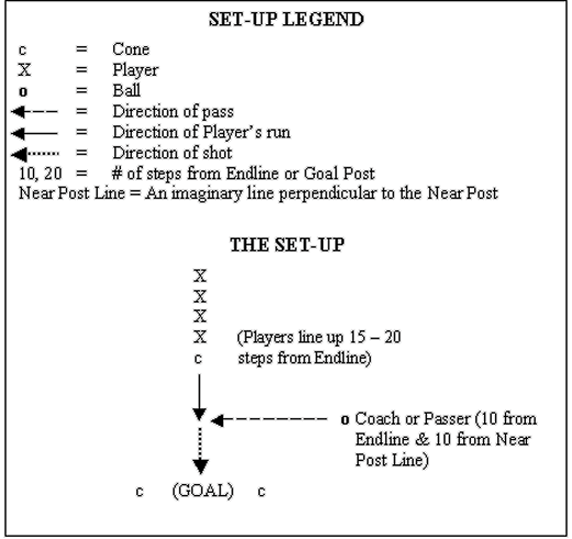Kick A Crossed Ball Game ™ (4-stars)
Timing shots and passes, U10 & up
Save $5 on SoccerHelp Premium - SoccerHelp Premium has 1,500 pages & 5,000 links for easy navigation. You can use the Coupon 5offpremium to subscribe to Premium for $10 for 30 days, $20 for 120 days, or $35 for a year. We do NOT automatically renew subscriptions. 15,000 Coaches have subscribed. 5-day money back guarantee. 400 Testimonials Sign up at http://soccerhelp.com/members/signup
Two advanced skills that require practice to learn are kicking a ball coming from the side (e.g., a crossed ball, which this drill teaches) and kicking a moving ball sideways. The "Kick A Crossed Ball Game" (this drill) and "Run To The Ball & Shoot With Side Of Foot" soccer drills are easy to set up and are time-efficient. If you wish, you can run them as drills or make them games by having players keep score. If you have more than 6 players, consider setting up 2 goals so there is less standing around.
About this soccer drill: A very important skill that requires practice to learn is kicking a ball coming from the side (e.g., a crossed ball). The difficulty with kicking a crossed ball is that it requires excellent timing -- we have all seen players totally mis-kick these balls -- in fact, they mis-kick them most of the time. Often the player is running toward the ball and timing the run is critical. It's also important to use the inside of the foot and to keep the head down. The "Kick A Crossed Ball Game" game is actually a teaching exercise, not a game, and it isn't one you will play a lot, and it's not a lot of fun. Nevertheless, it is an important skill to teach and once players understand the 4 Basics to Remember they should be able to handle a crossed ball better.
The 4 Important Teaching Points Are:
- Carefully time their run (take short steps as they get close to the ball)
- Short backswing (hardly any backswing - their forward momentum will produce the power)
- Head down
- Block the ball using inside of foot (Do NOT try to kick the ball hard - that causes mis-kicks)
Repeat the 4 basic teaching points over and over. This game is easy to set up and time-efficient, even with one line -- just keep it moving and have players retrieve their own ball if they are shooting thru cones, or go to the side if they are shooting into a net and wait until everyone has shot, at which time everyone gets their ball and the 2nd round starts. Only play this for 3 or 4 rounds. It should be enough to play it at one or 2 practices.
Objective:
Practice timing the run and how to kick a crossed ball.
Set-up:
- Ideally, a net or backstop to kick into. If no goal, put two cones 8 steps apart.
- Players line up 15-20 steps in front of the goal.
- Coach places all the balls 10-15 steps to one side, about 5-10 steps out from the goal.

The Game:
- Coach shouts "Go" and rolls or passes the ball straight across (parallel to the goal), like a soft crossing pass.
- On "Go", the first player in line starts his run forward to intercept the ball. (Tell players to start fast, taking long steps and as they reach the point of interception to take shorter steps).
- The player takes a short backswing and kicks the ball into the net. (Tell them to keep their head down, eyes on the ball, and to start out by blocking the ball using the inside of the foot. As they improve, they can try for more power, although much of their power should come from their forward momentum).
- After a while, stop saying "Go" and make the players watch the ball and start their run when it is passed.
- The Shooter either runs to retrieve the ball or goes to the back of the line.
Scoring:
One point for each successful run & contact and 2 points for each goal.
Advanced Progression:
Coach moves closer to the line of players (within 5 steps) & tosses the ball so it lands a few steps in front of the first player in line who should run onto the ball and volley it into the goal (ideally, strike it before it hits the ground, but if that isn't possible, strike it on the first bounce).